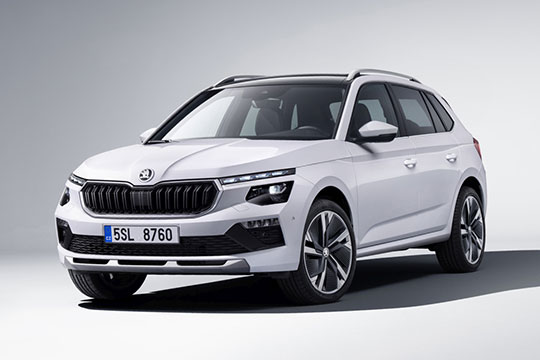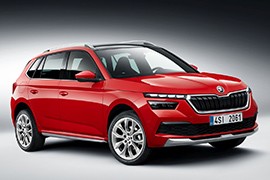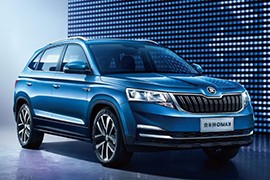SKODA Kamiq Models/Series Timeline, Specifications & Photos
First production year: 2018
Engines: Gasoline, Natural gas, Diesel
Body style: SUV (Sports Utility Vehicle)
In the summer of 2023, the Czech automaker Skoda introduced the refreshed version of its crossover Kamiq vehicle. The improved model brought significant updates to the car's exterior and interior. It also brought new, attractive drivetrain solutions.
Sharing its MQB-A0 platform with its compact-sized hatchback sibling Scala, the Kamiq was introduced on the market in 2019. It was the smallest and most successful Skoda SUV/crossover vehicle, with over 300,000 units sold. Besides its attractive price, the Kamiq was welcomed by customers also due to what it had to offer for daily situations, such as fuel-efficient engines, a comfortable interior, and a large enough trunk for a family of four. But, despite its crossover look, it was exclusively available with a front-wheel-drive platform.
For the refreshed version, Skoda installed a new grille up front, featuring vertical slats with chromed details to emphasize the car's importance in the automaker's lineup. The base trim level came with standard LED headlights, while the upper trim levels were available with Matrix-LED technology, previously reserved only for premium and expensive cars. But the Kamiq was none of these. It was just a simple, humble, jacked-up hatchback that played well in the family section. But that didn't keep Skoda on the side when it decided to improve the car's look. So, at the lower side of the front bumper, the car got a hexagonal mesh grille flanked on the sides by a pair of scoops. In addition, the automaker offered the option for LED fog lamps. The Kamiq featured sculptured door panels adorned with an ascending line that emerged from the lower side of the front doors to the rear quarter panels. Behind the rear doors, the raked-forward C-pillars got an angular shape on their lower side, emphasizing Skoda's cubist styling. Skoda adorned the back of the vehicle with corner-mounted taillights extended on the tailgate. Depending on the trim level and options, these LED lights were either stationary or with dynamic blinkers.
Inside, Skoda's engineers worked hard, and the carmaker's team found a solution to provide the vehicle with up to six levels of interiors. The Kamiq featured cloth upholstery for the lower grades, while the upper ones could've been ordered with suede or man-made leather with hand-stitched details. Thanks to the taller greenhouse than in the Scala, the Kamiq could provide more headroom for passengers. Still, the legroom for those seated on the split-folding bench in the rear could have been better. It was just enough, especially for kids or teenagers. On the dashboard, the automaker installed an 8-inch display fronting the driver. In addition, an 8.5” touchscreen for the infotainment unit sat above the center stack.
Skoda used only gasoline engines for the Kamiq ranging between 73 HP (75 PS) and 144 HP (150 PS) and paired with five or six-speed manuals or a seven-speed, dual-clutch, automatic gearbox. The Czech automaker also modified the vehicle's chassis and offered customers the option for a higher ground clearance for rough roads or a lower and stiffer one for those looking for a sportier look.
Skoda introduced the Kamiq lineup in 2019 as its most affordable crossover on the market, offering a car that could cover most needs of a regular family of four.
The Czech automaker created the Kamiq on the same platform as the Volkswagen T-Cross and its Spanish cousin, the Seat Arona. By sharing the same underpinnings with these vehicles and also with its sister hatchback Scala, the Kamiq could sit comfortably on the “affordable” side of the market. During the pandemic years, that was crucial, and the automaker managed to sell enough of them to stay afloat when the world had to shut down.
Skoda had its unique cubist design language that was used on all of its cars. As a result, the Kamiq carried over the same cues as those from the Scala, sporting a front fascia with eyebrow-like daytime running lights mounted at the edge of the hood above the fat bumper. The headlights, instead, were placed lower and had a trapezoidal shape. Between them, a black grille with vertical slats and a dent in its mid-section created a strong but not quite aggressive image for the vehicle. Lower, on the apron, the automaker added a broad air intake. As an option, customers could have the car with either halogen lamps or LEDs.
From its profile, the hatchback styling of the Kamiq resembled a Scala on stilts. The sculptured lines on the door panels and the ascending waistline ended into an upkick above the rear quarter panels were the same. A third glass area installed between the C- and D-posts enhanced the driver’s view. Finally, at the back, the raked forward tailgate sported part of the taillights that emerged from the rear fenders onto the rear fascia. Their angular design with narrower inner sides reflected Skoda’s cubist design language. As an option, and depending on the trim level, customers could get a set of underbody protections below the front and rear bumpers.
Even though Skoda was responsible for the creation of affordable vehicles within the Volkswagen Group, that didn’t mean that its products had to look cheap. Au contrary. Sometimes, they looked more upscale than other, pricier cars on the market. The Kamiq was available with a wide range of options, including sports seats for the front occupants, wrapped in leather and with integrated headrests. The base version, on the other hand, featured cloth upholstery and mundane-looking fabrics. Above the center stack, Skoda installed the 9.2” touchscreen for the infotainment system. Fronting the driver was either an instrument cluster with analog dials and a TFT display between them or a 10.25-inch Virtual Cockpit display.
The only downturn of this vehicle was that it was available exclusively with front-wheel drive systems and twisting beams at the back. This solution was adequate for most situations, although not the best available in the carmaker’s parts bin. Under the hood, Skoda installed a choice of three and four-cylinder engines, gasoline or turbo diesel, paired with six-speed manuals or seven-speed automatics (dual-clutch).
Skoda unveiled the subcompact crossover Kamiq at the 2018 Auto China 2018 and aimed not just at the Chinese market but at European customers as well.
The Czech automaker developed the Kamiq on the same platform as the Volkswagen T-Roc and the SEAT Arona. It was the smallest crossover in the Skoda’s inventory, placed below the compact-sized Karoq and the large Kodiaq. The new vehicle came to fill the needs of those looking for an affordable family vehicle that could handle well in crowded cities but also be able to tackle a few unpaved roads, even though it wasn’t offered with an all-wheel drive architecture due to the limited possibilities of the MQB A0 platform on which the car relied.
The Kamiq followed the automaker’s cubist design language but with some interesting twists. At the front, the headlights were positioned below the LED daytime running lights and flanked the wedged-shaped grille. Lower, on the bumper, a broad air intake crossed the apron from side to side, and underneath it, it sported a skid-plate-like plastic trim.
Skoda made the Kamiq’s profile resemble a subcompact-sized hatchback, with a raked and tall windshield and an ascending waistline. The B- and C-pillars were black, and only the raked-forward D-pillars placed at the back sported the body color. Antii Savio, the car’s designer, made the sculptured door panels to resemble those installed on the Skoda Scala and the Skoda Octavia. A set of contrasting-color side sills was available. The car rolled on 16” to 18” alloy wheels, depending on the grade and options. Skoda made the Kamiq available with standard LED lights both at the front and at the back for the taillights, which was not very common for this car’s segment.
Inside, the automaker worked hard to create a pleasant interior for its customers. The dashboard and many contact areas were covered by soft-touch materials. Even the base trim level featured a touchscreen for the infotainment system placed atop the center stack, although it was small. An eight-inch one featuring Android Auto and Apple CarPlay was available from the second grade, while the top trim level received a larger, 10.2” touchscreen with gesture control. In addition, that version also had a digital instrument cluster instead of an analog one. At the front, the bucket seats provided average side bolstering to keep their occupants in place, while at the back, a split-folding (60/40) bench seat was suitable for two occupants or a pair of child seats. There was limited legroom and elbowroom for a third, middle-seated passenger.
Under the hood, Skoda installed a range of turbocharged gasoline and diesel engines ranging between 95 PS (94 hp) and 150 PS (148 hp) paired with six-speed manuals or seven-speed automatics. Depending on the market, the Kamiq could also be equipped with a 1.0-liter CNG engine.


